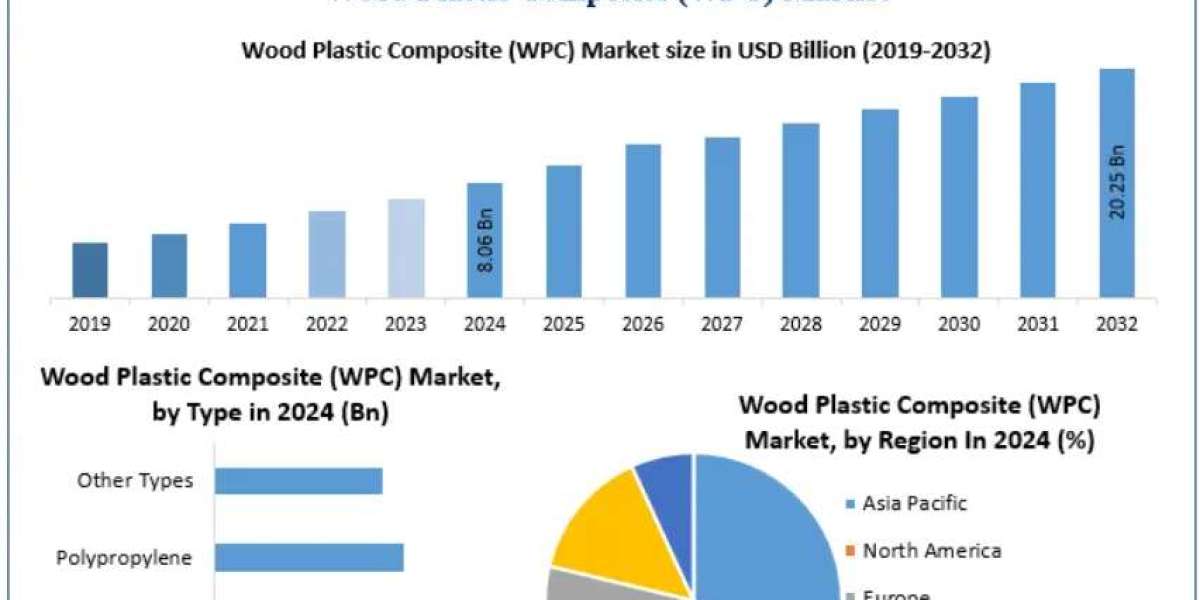Global Wood Plastic Composite (WPC) Market to Reach USD 20.25 Billion by 2032, Driven by Sustainability and Construction Demand
The Global Wood Plastic Composite (WPC) Market, valued at USD 8.06 billion in 2024, is set to expand at a robust CAGR of 12.2% from 2025 to 2032, reaching nearly USD 20.25 billion. Rising demand in the construction sector, increased focus on sustainable materials, and the adoption of recycled plastics in automotive applications are key growth drivers.
Market Overview
Wood Plastic Composites (WPCs) are hybrid materials made from wood fibers/wood flour blended with thermoplastics such as polyethylene (PE), polypropylene (PP), polyvinyl chloride (PVC), or polylactic acid (PLA). Known for their high bending strength, durability, low water absorption, and resistance to decay, WPCs are increasingly being adopted as a sustainable alternative to conventional wood.
They are widely used in flooring, decking, railings, fencing, cladding, interior molding, and automotive parts. Their ability to incorporate recycled plastics and additives such as colorants, UV stabilizers, and lubricants makes them versatile for diverse applications.
The most common manufacturing process is extrusion, though injection molding is also used depending on the end application. Among polymers, polyethylene (PE) dominates WPC production due to its cost-effectiveness and performance.
To know the most attractive segments, click here for a free sample of the report:https://www.maximizemarketresearch.com/request-sample/76219/
Market Dynamics
Key Drivers
Construction Boom: Rising demand for WPC in building and construction products such as decking, fencing, and cladding due to durability and low maintenance.
Environmental Regulations: Bans on hazardous chemicals like chromium, copper, and arsenic (CCA) in wood treatment have boosted WPC adoption as a safer alternative.
Recycled Materials: Increasing use of recycled plastics in automotive manufacturing enhances sustainability while reducing raw material costs.
Restraints
High Raw Material Costs: Fluctuating prices of plastics and wood fibers may hinder affordability.
Impact Resistance Issues: WPC materials tend to lack rigidity under heavy impact compared to pure wood or metal alternatives.
Opportunities
Growing Market Adoption: Rising awareness of eco-friendly products is expanding WPC’s presence in residential and commercial projects.
Ease of Processing: WPC is easier to mold and customize compared to conventional wood, encouraging product innovation.
Circular Economy: Utilization of recycled plastics as raw materials aligns with global sustainability goals.
Challenges
Weight Reduction: Developing lighter yet strong WPC products remains a technical challenge.
Regulatory Compliance: Legislation on recycled plastics and chemical additives can create barriers in certain markets.
Segment Analysis
By Application:
Building & Construction dominates the market, supported by demand for decking, railing, and cladding solutions.
Automotive Components are a fast-growing segment as automakers shift toward recyclable and lightweight materials.
Industrial & Consumer Goods contribute significantly, particularly in furniture and household applications.
By Polymer Type:
Polyethylene (PE) is the most widely used, offering a balance of cost and performance.
Polypropylene (PP) and PVC-based WPCs are also gaining traction for specific applications requiring higher heat resistance and rigidity.
By End-Use Industry:
Residential construction leads adoption due to decking, flooring, and fencing.
Commercial and industrial sectors are increasingly adopting WPC for structural and non-structural applications.
To know the most attractive segments, click here for a free sample of the report:https://www.maximizemarketresearch.com/request-sample/76219/
Regional Insights
Asia Pacific: Expected to dominate growth with large-scale construction projects in China and India. Government initiatives for smart cities and sustainable infrastructure boost demand.
Europe: Strong growth driven by strict recycling regulations and a preference for eco-friendly construction materials.
North America: Mature market, with high adoption of WPC decking and railing in residential housing.
South America & MEA: Emerging markets with growing construction and automotive sectors are set to provide new opportunities.
Competitive Landscape
The WPC market is highly competitive, with both global leaders and regional players focusing on product innovation, eco-friendly solutions, and expansion strategies. Key players include:
Trex Company, Inc.
The AZEK Company
Fiberon
UFP Industries Inc.
Advanced Environmental Recycling Technologies, Inc.
TAMKO Building Products, Inc.
CertainTeed, LLC.
Dow
MoistureShield
Polyplank AB
RENOLIT SE
Seven Trust
Green Dot Bioplastics Inc.
Beologic
Oakio Plastic Wood Building Materials Co. Ltd.
Meghmani Group
These companies are investing in lightweight WPC development, recycled raw materials, and global market expansion.
Future Outlook
The Wood Plastic Composite Market is poised for strong growth through 2032, driven by sustainability trends, regulatory pressures favoring recyclable materials, and expanding applications in construction, automotive, and consumer goods. Innovations in lightweight WPCs, biodegradable composites, and enhanced impact resistance will open new opportunities.
With construction projects booming in Asia-Pacific and sustainability driving adoption in Europe and North America, WPC is set to become a mainstream alternative to traditional wood across industries.














